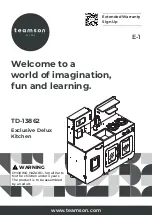
27
Take all batteries out of the model after use and store only in discharged mode
(ca. 0,9 V pro cell) at temperatures between + 5º and + 25º C. Keep batteries
out of the reach of children.
These notes are meant to alert you to the many dangers which can result from
incorrect and irresponsible handling. When practised properly and
conscientiously model flying is a creative, educational and relaxing leisure
activity.
Notes regarding the use of NiMH-batteries
Application area
All Graupner NiMH-batteries as well as NiMH-individual cells are exclusively suited
for model-making purposes such as for model aircraft, ships or cars.
Charging
1. Charge the NiMH-battery with a suitable charger or fast charger (see chargers in
the Graupner- main catalogue FS).
2. Before charging the battery must have cooled down to a temperature of around
20
°
C. If necessary use the cooling appliance BATTERY COOLER, order no.
2882 for cooling down the battery.
3. Charge the battery only immediately before use. Each NiMH-battery is subject to
a slight auto-discharge for technical reasons.
4.
Warning:
The charging process must be supervised even with fully automatic chargers.
Observe the maximum permissible charging current displayed on each battery or
individual cell. If the charging current is too high the NiMH-cells overheat. If the
battery heats up to 50
°
C during the charging process the charging current must
be interrupted immediately. By overheating of the NiMH-cells the overpressure in
the cell casing increases considerably. Each individual NiMH-cell of a battery is
equipped with an overpressure valve which protects the cell in emergencies from
a dangerous explosion. It is, however, possible that due to unpredictable
circumstances a valve will not function correctly so that an explosion may happen
in case of excessive overheating of the cell.
5.
Warning:
Do not touch accidentally overcharged NiMH-batteries, but interrupt the
charging current and allow the battery to cool down.
6.
Warning:
Avoid short-circuits by all means as the battery heats up immediately in the case
of an extremely fast discharge such as a short-circuit which can cause a cell
explosion just as in the case of overcharging. There is the risk of injury by
explosion and cauterisation from the electrolyte in the cell.
Avoid any skin or eye contact with leaked electrolyte. In an emergency rinse with
plenty of water and seek medical help.
7. Never solder cables or any similar objects directly onto the cell casing as this may
damage the overpressure valve.
8
Warning:
Never throw faulty or old NiMH-batteries into the fire.


































